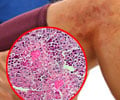It's not exactly your average aerobics class: the teacher is a physiotherapist, and the students are asthmatic.
It's not exactly your average aerobics class: the teacher is a physiotherapist, and the students are asthmatic.
And the gym is 130 metres (426 feet) below ground, in the world's oldest working salt mine.While the idea of a spell in the salt mines might conjure up visions of being sent to Siberia, Wieliczka is a benign venue for hundreds of patients who every year head to the underground sanatorium near Krakow, in southern Poland.
For 500 euros (690 dollars) -- which is often covered by health insurance -- the mostly asthmatic or allergic patients can spend 14 days deep in the mine's microclimate, breathing the therapeutic air.
"This air is absolutely beneficial for asthmatics, because they don't have any contact with allergens," said lung specialist Marta Rzepecka.
The patients get more than just a break from the dust and germs of the outside world, spending more than six hours a day on exercises and games which teach them to control their breathing.
The high levels of humidity and sodium chloride in the mine also help speed the regeneration of the mucous membranes, said Rzepecka.
Advertisement
"We also see an improvement in the overall functioning of the respiratory system," said physiotherapist Dorota Wodnicka.
Advertisement
Wieliczka, which is 15 kilometres (nine miles) from Krakow, has been mined for salt non-stop since the Middle Ages. It boasts an impressive network of galleries totalling 300 kilometers (186 miles) that not only house the sanatorium but have become a major tourist attraction and a UNESCO World Heritage site that draws more than a million visitors a year.
The mine's medical role dates back to the early 19th century, when Polish physician Feliks Boczkowski began using salt baths in 1826 to treat a variety of conditions. Among these were infertility, hysteria and even exhaustion due to "excessive" lovemaking.
The initial idea did not outlive Boczkowski: the salt-bath therapy ended at Wieliczka when he died in 1855.
The current sanatorium was opened a century later, and is among the most reputed of several dotted across central and eastern Europe.
Russian Liliana Prishchepa said she had brought her granddaughter from Moscow to Wieliczka on the advice of a friend from Ukraine who was treated here.
"Her problems disappeared after just two stays," said Prishchepa, adding that she hoped for the same result for little Anastasia.
But Wieliczka does not offer a magic wand, Rzepecka cautioned.
"Asthma is a chronic illness which is impossible to cure completely," she said.
"But medication plus care in a salt mine can force asthma into remission, in which sufferers don't have any symptoms, feel better, and have a better quality of life," she said.
Marzena Janowska, a Pole who lives in China, said she was simply delighted not to have to take strong medication for the duration of her stay at Wieliczka.
"Whenever I breathe outside, I have a pain in the chest. I feel better down here," she said.
Janowska said that she still considers medication to be the solution for her asthma, but added: "Sometimes it's better to try natural methods first."
The site already generated interest in the 14th and 15th centuries, when lore says privileged royal guests would be give a tour of its labyrinth of passageways and chambers.
Today aside from the clinic, other curiosities at Wieliczka include an impressive underground cathedral carved from the salt and rock, statues sculpted from the salt, a museum with artworks and underground lakes.
Source-AFP
LIN/C











